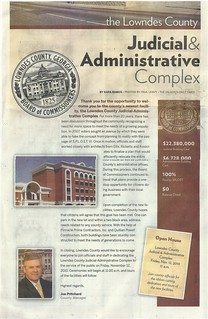Bainbridge City Hall now hums with solar energy, Tristan Baurick wrote for Kitsap Sun 2 August 2012:
City Hall’s array of 297 rooftop solar panels is expected to produce the equivalent of 20 percent of the building’s energy needs, according to Joe Deets, executive director of Community Energy Solutions, the Bainbridge nonprofit group that spearheaded the privately-funded project.
“This is a great day for Bainbridge,” Deets said.
How many solar panels do you see on Valdosta City Hall? Well, that’s a historic building. But how about City Hall Annex? The parking lot? The formerly “100% Paid by SPLOST” Lowndes County palace that we’re now paying almost $9 million in bonds for? Nope, not a solar panel in sight.
Oh, sorry, that’s Continue reading














